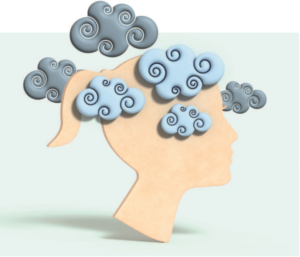Sometimes Invisible: How to Spot ADHD Without Hyperactivity
Attention Magazine October 2022
Natalie was sitting in her classroom chair listening to her teacher, but then she started thinking about her upcoming playdate. Then she noticed that the girl in front of her had a label sticking out. Then she looked out the window to see a squirrel scurrying up a tree. She suddenly realized that she had lost track of what the teacher was saying.
An intelligent, high-achieving child, Natalie works hard in school and gets excited about many things. However, she often loses attention and doesn’t finish projects or assignments. She frequently seems distracted and to not really be listening. She often loses items and struggles with organization.
 WHEN WE THINK OF ADHD, many of us think of a hyperactive and impulsive child who is always in motion and interrupts or talks excessively. Observing these children, many parents and teachers consider that it might be ADHD and move forward with an evaluation.
WHEN WE THINK OF ADHD, many of us think of a hyperactive and impulsive child who is always in motion and interrupts or talks excessively. Observing these children, many parents and teachers consider that it might be ADHD and move forward with an evaluation.
Many children have a different kind of ADHD that is more likely to be overlooked, however. These children do not fit the hyperactive and impulsive profile. Instead, their behavior is compliant, and they often succeed in school. Nevertheless, they may be struggling without any obvious signs. This type of ADHD used to be called ADD—attention deficit disorder without the H for hyperactivity. Now, the term ADHD refers to anyone with the disorder, and three presentations are recognized—predominantly inattentive, predominantly hyperactive-impulsive, and combined.
This presentation of ADHD, which affects girls in particular, is most often overlooked. And while many of these children and adults are able to get by with workarounds, an accurate diagnosis could improve so many of their lives.
Natalie eventually was diagnosed with ADHD, inattentive presentation. This presentation of ADHD is characterized primarily by inattention and distractibility without hyperactivity. Natalie was prescribed medication and received therapy to help her focus and sustain attention. She also began working with an executive function coach to teach her strategies to become more organized. This presentation of ADHD, which affects girls in particular, is most often overlooked. And while many of these children and adults are able to get by with workarounds, an accurate diagnosis could improve so many of their lives.

Diagnosis and treatment of inattentive ADHD
Many people struggle with organization, forgetfulness, and distractibility. To receive a diagnosis of ADHD, however, the symptoms must interfere with their life, impairing social or occupational functioning. The DSM-5 lists nine symptoms of inattentive ADHD. In a child or adolescent, at least six of these must be present and must significantly disrupt the child’s life in order to merit a diagnosis. The symptoms must have been present for at least six months and be inappropriate for the child’s developmental level. These are the symptoms to look for:
- Often fails to give close attention to details or makes careless mistakes in schoolwork, at work, or with other activities.
- Often has trouble sustaining attention on tasks or play activities.
- Often does not seem to listen when spoken to directly.
- Often does not follow through on instructions and fails to finish schoolwork, chores, or duties in the workplace (loses focus, gets sidetracked).
- Often has trouble organizing tasks and activities.
- Often avoids, dislikes, or is reluctant to do tasks that require mental effort over a long period of time (such as schoolwork or homework).
- Often loses things necessary for tasks and activities (such as school materials, pencils, books, tools, wallets, keys, paperwork, eyeglasses, phones).
- Is easily distracted.
- Is often forgetful in daily activities.
These symptoms can apply to adults or children, although behaviorally they might look somewhat different in adults and children. Since ADHD is inherited, many adults look at themselves while having their children evaluated and realize that they have some of the same symptoms. Note, however, that according to the DSM-5, adults need show only five out of the nine symptoms, rather than the six required for diagnosis in a child.
Look carefully at the word often. Many if not most of us sometimes exhibit these symptoms. Let’s look more closely at the first two and consider the reasons they could occur.
- Often fails to give close attention to details or makes careless mistakes in schoolwork, at work, or with other activities. Reasons for this could be:
- In a hurry or looking forward to something else
- Not a detail-oriented person
- Doesn’t remember to check work
- Doesn’t understand instructions
- Has a learning disability
- Has a visual or hearing impairment
- May have ADHD
- Often has trouble holding attention on tasks or play activities. Reasons could be:
- Anxiety or depression
- Doesn’t enjoy the task
- Doesn’t see the importance of the task
- May have ADHD
Since there are so many potential causes of the nine key symptoms, it is important to get a proper evaluation if you suspect ADHD or any other disorder that is impairing daily life. If you think these symptoms are severe enough to suspect ADHD, it is worth getting evaluated. The first step is to see a primary physician to get a health evaluation, including vision, hearing, anxiety, and depression. The physician may recommend a visit with a psychiatrist or psychologist to get a neuropsychological or psychoeducational evaluation. The physician may prescribe a medication to get started.
Once a child or adult is diagnosed by a qualified health professional, the following treatments are proven to be beneficial:
- medication, which can be a stimulant or nonstimulant, is a game changer for people who struggle with ADHD symptoms, helping them focus, complete tasks, and be more organized.
- a life coach or academic coach can help with organization, time management, focus, motivation, and goal setting.
- a tutor can help students study more efficiently and learn techniques for organizing their work, mastering new memory strategies, and improving their writing skills.
- a support group can help students discuss their challenges and strategies.
Strategies to address inattentive ADHD symptoms
 Meanwhile, there are many strategies we can teach individuals to address the symptoms of inattentive ADHD.
Meanwhile, there are many strategies we can teach individuals to address the symptoms of inattentive ADHD.
When I started my tutoring practice in 1994, I knew that I struggled with organization, and I knew I had to improve these skills to successfully start and run my new business. I had the bad habit of writing everything on sticky notes and distributing them all over my desk. Then I hired the most organized person I knew to help me get organized. She worked with me for three days.
The first thing she did was discard the sticky note approach, which she replaced with a spiral notebook to write everything down. To this date, I have probably completed hundreds of spiral notebooks. She helped me in other ways, too, and the business was quickly organized and running smoothly. Even though I was not a naturally organized person, I learned strategies to keep order and be successful.
For parents of children with inattentive ADHD—as well as adults with this presentation—here are some tips and strategies for success in areas where symptoms may impede.
- Instructions. Regarding school assignments and household requests, make sure instructions are clear. Ask your child to repeat the instructions to make sure they are understood. Limit tasks to two or three at a time. For big projects, break them down into small chunks.
- Distractions. Students in school can receive simple accommodations like preferred seating in front or center and taking tests in a smaller group. At home, keep homework space clear of distractions like phones, televisions, and other people.
- Completion of tasks. Tasks do not need to be completed all at once. If attention span is short, set a timer for twenty-minute intervals with five-minute stretch breaks. Incorporate exercise before tasks and during breaks to get dopamine flowing. (This may improve motivation.)
- Routine. Many people, especially those with ADHD, do their best with a regular routine. This includes predictable wake-up times, bedtimes, mealtimes, homework times, and fun times.
- Organization. ADHD is often associated with executive function challenges, such as organizing time and space, and organizing thoughts to write an essay. Some helpers include timers, graphic organizers, to-do lists, planners, and calendars.
- Rewards. Many of us are more motivated when we have a reward coming. This can be extra screen time, a special trip, and praise for hard work.
- Listening. Make sure your child (or spouse) is looking at you when you are talking without simultaneously looking at a screen. Keep your comment brief and make sure there is an appropriate response. If there isn’t, ask your child to repeat what you said. If you want your child or spouse to listen to you, make sure you listen to them.
- Forgetting or losing things. Assign regular places in the house, bedroom, playroom, and backpack where everything belongs. Put everything in the backpack at night. Write down notes on what to remember on paper or in the note section of your phone.


